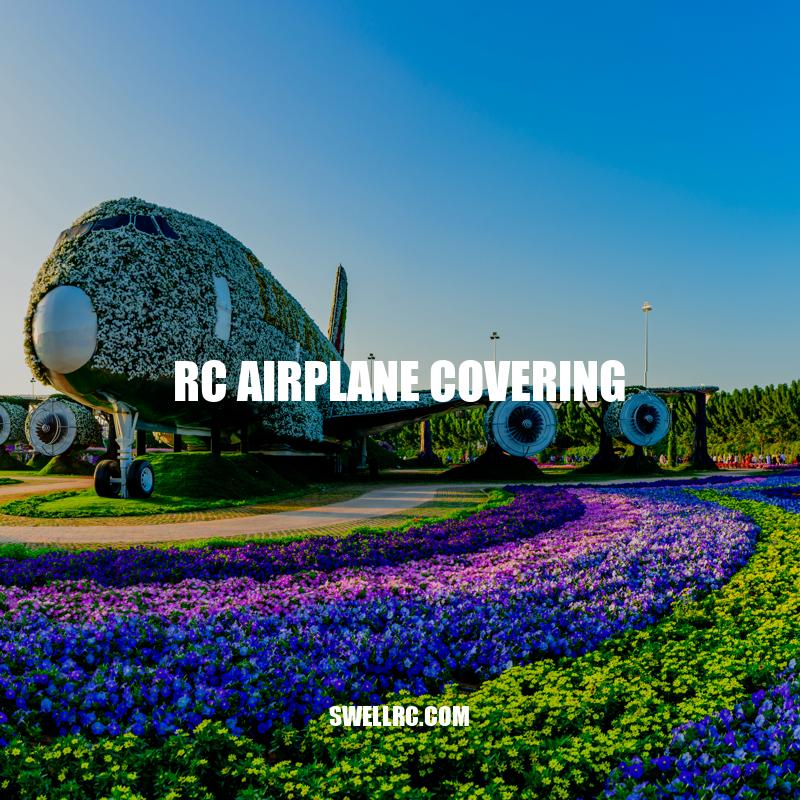Mastering RC Airplane Covering: Tips and Tools for High-Quality Results.
As a RC airplane enthusiast, you know the importance of proper covering for your beloved miniature aircraft. RC airplane covering refers to the process of covering the outer surface of the airplane with a lightweight material that is designed to protect the airplane, enhance its performance, and make it look visually appealing. The covering material used for RC airplanes is heat-resistant and adheres to the airplane’s surface when heated. This process is done using a combination of heat and adhesive, which makes the covering adhere seamlessly to the airplane’s surface without any wrinkles or bubbles. To get the best result, it’s essential that you are well-versed in the RC airplane covering process and have the right tools and supplies for the job. In this article, we delve into the essential aspects of RC airplane covering that every enthusiast needs to know. From covering materials to best practices, we will guide you through everything you need to know to take your RC airplane to the next level.
Covering Materials and Types
RC airplane covering materials come in different types and colors, and each option has its own pros and cons. Here are some of the most common materials available on the market today:
- Monokote: Made by Top Flite, Monokote is a PVC film material that is highly durable and impact-resistant. It’s known for its flexibility and ease of use.
- Ultracote: Ultracote is another popular covering material that is also PVC-based. Manufactured by Hangar 9, this covering material is easier to apply than Monokote and also has a wide range of colors and patterns available.
- Coverite: Coverite is a durable polyester fabric that is heat activated and can be easily shaped to the surface of the airplane. The material is widely used for both indoor and outdoor RC planes because of its strength and lightness.
There are several other covering materials available on the market, but Monokote, Ultracote, and Coverite are the most popular options. Each covering material has its own features and characteristics, and the choice you make depends on your personal preference, the purpose of your RC airplane activity, and your budget. You can easily purchase these covering materials from any hobby store or major online retailers such as Tower Hobbies or Horizon Hobby.
What are the different types of aircraft fabric covering?
The different types of aircraft fabric coverings include:
- Cotton: A lightweight and economical option.
- Cotton-polyester blend: Has the durability of polyester and the breathability of cotton.
- Polyester: A strong and lightweight option that has gained popularity in recent years.
- Dope and fabric: A traditional method where the fabric is stretched over the aircraft frame and coated with layers of dope to provide protection against weather and ultraviolet rays.
- Pre-sewn envelopes: A modern method where pre-made fabric panels are attached to the aircraft frame using tensioning systems.
It is important to carefully consider the type of fabric covering for your aircraft based on factors such as durability, weight, and cost.
For more information on aircraft fabric coverings, refer to the Federal Aviation Administration’s (FAA) Fabric Covering Regulations. Additionally, companies such as Aircraft Spruce and Wicks Aircraft Supply offer a variety of fabric coverings and related products for aircraft.
Covering Process
The covering process is a critical step in ensuring the durability and performance of your RC airplane. Here are some steps to help you during the process:
- Prepare the airplane: Clean the surface of the airplane and remove any dirt, dust, or old covering that may be present. Sand off any imperfections and make sure the surface is smooth and ready for the new covering.
- Measure the covering: Measure the covering material you are using and cut it based on the size of the airplane and the dimensions of the surfaces you are covering. Leave some extra material to ensure a good wrap around the edges.
- Apply the adhesive: Apply the adhesive of your choice onto the surface of the airplane using a brush or spray adhesive. Use a blow dryer or a heat gun to help flatten the adhesive on the surface.
- Apply the covering: Carefully place the covering material over the surface of the airplane, making sure it is straight and wrinkle-free. Use a heat gun to shrink the covering material and smooth out any wrinkles or bubbles that may appear.
- Trim off the excess: Once the covering material is in place and secured, trim off the excess material using a sharp X-Acto knife. Be careful not to cut too deep and damage the surface of the airplane.
- Final fittings: Iron the coverings from top to bottom to make sure they’re tight and protect it from wrinkles.
Using a covering sock and socking iron is suggested for a flawless finish.
A Brief Overview of Adhesives Used in Aircraft Covering
| Name | Type | Features |
|---|---|---|
| Dope | Nitrate or Butyrate | Fast drying, easy to apply and sand, heat-resistant, low weight |
| Epoxy | Two-part Resin | Long working time, water-resistant, shock-resistant, ideal for large and heavy planes |
| Cyanoacrylate | Super Glue | Fast-drying, strong bond, easy application, great for quick fixes |
Did you know that RC airplane covering was discovered in the 1930s with the introduction of lightweight plastic coverings? Another interesting fact is that there are several online forums and communities where RC airplane enthusiasts share tips, advice, and knowledge about covering airplanes. Some of the popular websites for purchasing covering materials and tools are Tower Hobbies, Horizon Hobby, and Amazon.com.
How do you cover a model airplane?
To cover a model airplane, follow these quick steps:
- Clean the surface of the airplane’s frame or wings to remove dirt and debris.
- Cut the covering material, such as heat shrink film, to the appropriate size and shape for the airplane.
- Place the covering material over the airplane, leaving a bit of extra material on all sides.
- Use a heat source, such as a heat gun or iron, to activate the adhesive on the covering material and smooth out any wrinkles or bubbles.
- Cut and trim away excess covering material.
- Optional: add decals or graphics to customize the airplane’s appearance.
For more in-depth instructions and tips, websites like Model Airplane News and RC Groups offer tutorials and forums for model airplane enthusiasts. Additionally, products like the Trim Monokote Trim Seal Tool or the Sealing Iron for Covering Model Airplane Balsa Wood also offer helpful assistance in covering and sealing model airplanes.
Tools and Supplies
To ensure you have a successful RC airplane covering experience, it’s essential to have the right tools and supplies. Here are some of the most important items to have on hand:
- Covering material: There are various types of covering materials available, including Monokote, Ultracote, and Coverite.
- Covering iron and heat gun: These items are necessary to seal the covering material onto the airplane surface, remove wrinkles, and tighten up the finish.
- Covering adhesive: This is the glue that will hold the covering material onto the airplane surface. If you’re not sure where to start, Coverite and Balsarite are reliable brands to consider.
- X-Acto knife: This sharp knife is required to trim the excess covering material once it’s been secured onto the surface of the airplane.
- Balsa stripper: This is a specialized tool that’s used to strip balsa wood of its bark or outer layer, exposing a more workable wood surface that can be sanded and painted with ease.
- T-pins: These are used to help hold the covering material in place while you’re applying heat to make sure it’s wrinkle-free.
- Blow dryer: This can be used in place of a heat gun to help flatten out the adhesive and covering material.
When it comes to purchasing these tools and supplies, you have several options. You can find them at your local hobby store, or you can order them online from popular websites like Horizon Hobby or Tower Hobbies.
Table: Tips for a Flawless RC Airplane Covering Job
| Tips | Description |
|---|---|
| Take your time | Don’t rush through the process. A slow and steady approach helps avoid mistakes and get the desired result. |
| Use the right material for the job | Pay attention to the weight and flexibility of the covering material, depending on what type of aircraft you’re working on. |
| Check for bubbles and wrinkles | Regularly check the surface of the covering material for bubbles or wrinkles that could impact the final finish. |
| Apply heat carefully | Make sure not to overheat or melt the covering material during the application process. This can affect the color of the material and lead to uneven or unsightly results. |
| Practice on scrap pieces first | Before diving into the actual covering job, practice on some scrap pieces to get a better understanding of the process. |
By following the above tips, and having the right tools and supplies, you’ll be sure to have a professional-looking RC airplane covering job.
How do you cover an RC plane?
To cover an RC plane, you can follow these steps:
- Clean the surfaces of the plane to remove dirt, oil, and grease.
- Cut out the covering material to a size that will fit the planes’ surfaces.
- Peel the backing paper from a corner of the material and place the sticky side onto the surface of the plane.
- Use a heat gun to shrink and tighten the covering material. Start from the center and work your way towards the edges.
- Cut openings for wings and control surfaces.
- Use an iron to seal the edges of the material for a smooth finish.
Various websites offer a wide range of covering materials for RC planes, such as Hobbyking, Tower Hobbies, and Horizon Hobby. You can also find instructional videos on YouTube that demonstrate the covering process in detail.
Conclusion
RC airplane covering may seem like an intimidating process at first, but with the right knowledge, tools, and materials, anyone can do it. Proper covering keeps your airplane looking sleek and professional, while also protecting it from the elements. Remember, take your time during the covering process, prepare your workspace, and use the right materials and tools to ensure you have a successful experience.
If you’re new to RC airplanes, there are plenty of resources available to help you learn. Check online forums, hobby shops, and even YouTube tutorials to get started. Don’t be afraid to ask questions or seek advice from experienced hobbyists in your community.
By mastering the art of RC airplane covering, you’ll not only have a functional aircraft but also a work of art that you’ll be proud to showcase. Happy flying!



